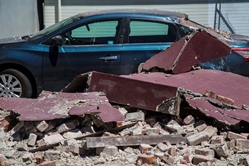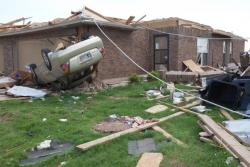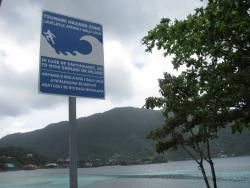Biological agents are bacteria, viruses and toxins that can disable or kill people, animals, and crops. Visit these sites to learn what you can do before, during and after a biological threat.
Biological Threats – Learn what biological agents are and how they can be spread. You can also learn what to do to prepare and what to do if you’re exposed. (Ready.gov)
Bioterrorism – Learn what bioterrorism is and the categories of biological agents. You can also learn about specific agents and get fact sheets. There’s also information for healthcare professionals and first responders. (Centers for Disease Control and Prevention)
Biodefense and Bioterrorism – Learn about agents like anthrax and smallpox as well as research, treatment, and tests. There’s also an option for you to sign up for email updates. (U.S. National Library of Medicine)
Bioterrorism and Drug Preparedness – Learn about drug therapy and vaccines, and advice on medication for certain biological agents. (U.S. Food and Drug Administration)
Chemical threats can come from things like terrorist attacks, or industrial or transportation accidents. They can even come from products used at home. The sites below can help you learn about different kinds of chemical dangers and what you can do to prepare for or respond to a threat.
To report oil and chemical spills: Call the National Response Center (NRC) toll-free at 1-800-424-8802.
To report poison-related emergencies: Call the American Association of Poison Control Centers (AAPCC) toll-free at 1-800-222-1222.
Chemical Threat Information – Learn what chemical agents are and how they can be released. You can also learn the possible signs of a chemical attack and what you should do if you’ve been exposed. (Ready.gov)
Household Chemical Emergencies – Learn the guidelines for safely buying and storing chemicals in your home, and what to do in an emergency. (Ready.gov)
Chemical Emergency Preparedness – Learn how you can prevent chemical accidents as well as prepare for an emergency. You can also learn how you may be exposed to a chemical and how to respond. (American Red Cross)
Chemical Emergencies Overview – Learn what chemical emergencies are and the different chemical types. You can also learn about sheltering in place, evacuation, and decontamination. And there’s information for healthcare professionals and first responders. (Centers for Disease Control and Prevention)
Droughts are one of the most costly natural disasters that affect the U.S. Visit these sites to learn how you can prepare for and recover from a drought.
U.S. Drought Portal - View maps, local news, and fact sheets to help you monitor droughts in your area. (National Oceanic and Atmospheric Administration)
National Drought Mitigation Center - Get current news and monitoring tools, and learn how to plan for a drought. There’s even a section just for kids! (University of Nebraska–Lincoln)
Drought Preparedness and Water Conservation - Learn the four types of drought and what they affect. You can also learn how to conserve water indoors and outdoors. (American Red Cross)
Water Conservation Tips - Learn how you can save water in the bathroom, kitchen, laundry, and outside your home. (Washington Suburban Sanitary Commission)
Did you know that 45 states are at a moderate to high risk for earthquakes?
Many people believe earthquakes only happen on the West Coast, but it’s important for everyone to be ready for this type of disaster. These sites can help you learn how to prepare for and recover from an earthquake.
Earthquakes - Learn what to do before, during, and after an earthquake. (Ready.gov)
Earthquake Preparedness - Learn about risks and get an Earthquake Safety Checklist. You can learn how to prepare for and what to do during an earthquake, both inside and outside. And learn what you should do and how to let your family know you’re safe after an earthquake. (American Red Cross)
Surviving an Earthquake - Find out how to prepare ahead and deal with home hazards. Learn about what to do in specific situations during an earthquake. Like if you’re in a crowded public place or have impaired mobility. You can also learn what you need to know about food, water, and other safety issues after an earthquake. (Centers for Disease Control and Prevention)
Earthquakes can trigger fires, floods, landslides and tsunamis, so it’s good to learn how to stay safe from these hazards, too.
Fires can start by accident, acts of nature, or even by arson. You can help keep your family and co-workers safe during a fire by making sure smoke alarms work and by practicing a fire escape plan. The resources below can help you learn what to do to prevent or recover from a fire.
Home Fires - Learn fire facts and safety tips, and how to prevent home fires. You can learn how to create a fire escape plan, what to do during a fire, and get a checklist to help you after a fire. There’s also information for older adults and people with access or functional needs. (Ready.gov)
Home Fire Safety - Get a “Home Fire Safety Checklist” and a worksheet to help you create a “Home Fire Escape Plan.” You can also learn how to prevent fires, as well as what to do during and after a fire. (American Red Cross)
After the Fire: Returning to Normal (PDF, 406 KB) - Learn what to expect and how to handle the damage after a fire. There’s also a checklist to help you record vital details to keep on file. (FEMA)
Floods are one of the most common hazards in the U.S. They can affect areas as small as a local neighborhood or community, to as large as an entire river basin and multiple states. Flooding often results from another disaster, like a hurricane. These resources can help you learn what you need to know to respond to a flood threat.
Floods - Learn some flood terms, facts, and safety tips to help you before, during, and after a flood. You can also read about flood insurance. (Ready.gov)
Key Facts About Flood Readiness - Learn basic steps to prepare for a storm and pending evacuation. You can find out what to do if you’re under a flood watch or warning, and what emergency supplies you need. The site also has information about clean-up and food and water safety after a flood. (Centers for Disease Control and Prevention)
Flood Safety Checklist (PDF, 80 KB) - Get a checklist that answers three questions to help you prepare for a flood: What should I do? What supplies do I need? What do I do after a flood? You can also learn about the “Safe and Well” website. It allows you to register to let your family know you’re safe. (American Red Cross)
What Consumers Need to Know About Food and Water Safety - This page offers food and water safety facts to help you prepare for and respond to a hurricane, power outage, or flood. For floods, you can learn specific steps to help keep water and food safe during and after a flood. There’s also a link to a PDF file if you want to save a copy of the information. (Food and Drug Administration)
Flooding - Get tips on how to recover after a flood. Things like how to use a generator safely, how to handle private wells and septic systems, disaster debris, mold, clean-up and renovation. You can also find information on water and food safety. (Environmental Protection Agency)
Most illnesses and death from extreme heat are preventable. But every year hundreds of people die from heat-related causes. It’s important for everyone to know what the risks are and who is most at risk. You should also be able to recognize the symptoms and take action quickly.
The following resources will help you prepare and know how to respond to extreme heat.
Prepare for Extreme Heat - Learn some terms to help you identify extreme heat hazards, and the conditions that can cause related illnesses. You can also learn things you can do to stay safe during a heat wave. (Ready.gov)
Stay Healthy During Extreme Heat - Find out how to prepare for extreme heat, including what communities and businesses can do to reduce energy demands. Learn how to prevent heat-related illnesses, and what to do if the power goes out. And don’t forget about your pets! (Environmental Protection Agency)
Extreme Heat - Get hot weather tips and read the “Extreme Heat Prevention Guide.” You can also find safety information for people groups like the elderly, children, and outdoor workers. (CDC)
Heat Wave: A Major Summer Killer - Learn what the “Heat Index” is and illness risks at different stages. Learn heat wave safety tips, how heat affects the body, and the symptoms and treatment for heat disorders. (National Weather Service)
Heat Wave Safety - Find out what “Excessive Heat Watch,” “Excessive Heat Warning,” and “Heat Advisory” means, and what you can do to prepare. Learn how to respond during a heat wave, and how to treat heat-related illnesses. You can also get a “Heat Wave Safety Checklist”. (American Red Cross)
According to the National Hurricane Center, from 2004 to 2013 hurricanes killed an average of 108 people in the U.S.
These resources can help you plan, and learn how to respond to a hurricane.
Hurricanes - Learn terms, facts, and safety tips to help you before, during, and after a hurricane. You can also read about the Saffir-Simpson Hurricane Wind Scale and the five hurricane categories. (Ready.gov)
Hurricanes and Other Tropical Storms - Learn how to make a hurricane plan, what supplies you’ll need, and how to prepare your home. Learn how you can stay safe after a hurricane, and keep your food and water safe. (Centers for Disease Control and Prevention)
Hurricane Safety Checklist (PDF, 80 KB) - Get a one-page checklist to help you prepare and respond to a hurricane. Learn what supplies you’ll need and what to do after. (American Red Cross)
Hurricanes - Information for Protecting Health and the Environment - Learn how to prepare before a hurricane. How to plan for things like drinking water, food, and disaster debris. Also learn how to handle other health and safety hazards like flooding and mold. (Environmental Protection Agency)
Medical Devices and Hurricane Disasters - Get safety tips for using medical devices during and after a hurricane. Learn how you should deal with power outages, water, heat and humidity, and keeping things sterile. There’s also a special section about blood glucose meters. (Food and Drug Administration)
Landslides can happen anywhere, under many different conditions. Visit these sites to learn the causes, how to protect yourself, and how to respond.
Landslide or Debris Flow - Learn some landslide warning signs. Also, get tips to help you protect yourself and your property before, during, and after a landslide. (Ready.gov)
Landslides Safety Check List (PDF, 76 KB) - Get tips on what you should do: If you live in a landslide risk area; if a landslide is occurring or likely to; after a landslide has occurred. There’s also a list to help you prepare in case you need to evacuate. (American Red Cross)
Landslides and Mudslides - Get a fact sheet about the causes, health threats, and risks of landslides. Learn what you can do to prepare, and how to respond during and after. (Centers for Disease Control and Prevention)
Landslide Hazards Program (LHP) - The program’s goal is to reduce long-term losses from landslides by improving our understanding of the causes. On the site, you can find things like landslide news, state and local information, FAQs, and a glossary. There’s also a link for reporting landslides. (U.S. Geological Survey)
Landslides can be triggered by other disasters, like earthquakes, fires, floods, hurricanes, or volcanic eruptions. Visit these sections to learn more about each disaster type.
Radiation emergencies can come from terrorist attacks or nuclear power plant accidents. The worst commercial nuclear power plant disaster in the U.S. was the Three Mile Island accident on March 28, 1979. No deaths were linked to the incident, but it took 13 years and cost about $1 billion to clean up the damage.
Visit the websites below to learn how to prepare for and recover from a radiation or nuclear event.
Nuclear Power Plant Emergency - Learn the potential radiation exposure danger from a nuclear power plant emergency. Learn how to prepare a supply kit and how to make a family emergency plan. You can also find out what you should do during and after the emergency. (Ready.gov)
Nuclear Blast - Learn what a nuclear blast is and the hazards of nuclear devices. Learn how to prepare your home and family before a nuclear event, and what you should do during and after. (Ready.gov)
Hazardous Materials Incident - Find out what different hazardous materials are and where they can be found. Learn how to build an emergency supply kit; how to protect yourself during a hazardous materials incident and what you should do after. (Ready.gov)
Contamination vs. Exposure - Learn the difference between contamination and exposure, and how you can limit contamination. (Centers for Disease Control and Prevention)
Acute Radiation Syndrome (ARS) - Find out what you need to know about radiation sickness. Learn how you can get it, what the symptoms are, and how it’s treated. (Centers for Disease Control and Prevention)
Potassium Iodide (KI) - Read frequently asked questions about the use of KI in radiation emergencies. (U.S. Food and Drug Administration)
According to the National Oceanic and Atmospheric Administration (NOAA), tornadoes come in all shapes and sizes, and can occur anywhere in the U.S. at any time of the year. In the southern states, peak tornado season is March through May, while peak months in the northern states are June and July.
These resources can help you prepare before and safely recover after a tornado.
Prepare for a Tornado - Learn what supplies you should prepare ahead and how to plan for disaster debris. You can also get information about water and food safety, and health concerns. And find out how to report hazardous material spills. (Environmental Protection Agency)
What to Do During a Tornado - Get tornado facts and learn the conditions to stay alert for. Find out how to shelter in different structures or even if you’re outside. Learn how to stay safe, inspect the damage, and clean up after a tornado. There’s also information on how to prepare a safe room. (Ready.gov)
Tornado Safety - Learn the difference between a “tornado watch” and “tornado warning,” and the danger signs to watch for. Read about warning systems, and how to prepare your family and your home ahead of the storm. Learn what to do to stay safe during a tornado and how to recover after. (American Red Cross)
Tornadoes - Get information on how to prepare before a tornado, and how to stay safe during and after. Learn what to do when you reenter your home, and how to safely handle flooding or debris. (Centers for Disease Control and Prevention)
A tsunami is a series of waves caused by any large shift in an area of seawater. Most are caused by earthquakes, but they can also be caused by volcanic eruptions, landslides, undersea slumps, or meteorite strikes.
The resources below can help you learn about and prepare for a tsunami.
Tsunamis - Find out how to protect yourself and your family before a tsunami. Learn how to make a family communication plan and what the warning signs are. Learn what to do during a tsunami and how to stay safe after. (Ready.gov)
Warnings and Forecasts - Learn how the Tsunami Warning System works and how to respond. You can also find links to other tsunami information like “The Tsunami Story,” event databases, and news articles. (NOAA)
Emergency Preparedness and Response - Tsunamis - Find information on the health concerns and effects of tsunamis. You can also get tips on food and water safety. (Centers for Disease Control and Prevention)
Tsunami Preparedness - Learn the warning signs of a tsunami and the best sources for information. Get tips on how to prepare and be aware of the area around you. You can also learn how to respond during a tsunami, what to do after, and how to let your family know you’re safe. (American Red Cross)
Tsunami Hazard Mitigation - Get facts about tsunamis, and learn what to do if you’re on land or in a boat when one hits. (Tsunami! The Great Waves)
Most active volcanoes in the U.S. are in Hawaii, Alaska and the Pacific Northwest. The danger area near a volcano covers about a 20-mile radius. Some danger, though, may exist 100 miles or more away.
Visit these resources to find out how to prepare for and respond to a volcanic eruption.
Volcanoes - Learn the many hazards of a volcanic eruption. Learn how to build an Emergency Supply Kit and make a Family Emergency Plan. Learn what you need to be aware of during an eruption, and how to find shelter and information after. (Ready.gov)
Volcano Preparedness - Do you live in a known active or dormant volcano area? If so, you need to know about your local warning systems and emergency plans. Learn the other hazards that can be caused by an eruption and how to prepare before an event. Find out what to do during an eruption, whether indoors or outdoors, and how to protect yourself during ashfall. You can also get tips on how to stay safe after. (American Red Cross)
Volcanoes - Get information about how to prepare for a volcanic eruption. You can also learn how the EPA responds and about the health and environmental impacts after. (Environmental Protection Agency)
Key Facts About Protecting Yourself After a Volcanic Eruption - Get advice on how to protect yourself and your family after an eruption. There are also links to help you learn about other hazards that can occur with an eruption. (Centers for Disease Control and Prevention)
Volcanic Ash - Learn what ash is, what it can do, and how to prevent damage. Get tips on what actions to take for clean-up and disposal. You can also view two brochures about volcanic ask from the International Volcanic Health Hazard Network (IVHHN). (U.S. Geological Survey)
According to the National Interagency Fire Center, between 2004 and 2013, wildfires burned an average of 6.8 million acres and cost an average of $1.5 billion each year.
The resources below can help you prepare for and recover from a wildfire.
Wildfire – Learn how to prepare for a wildfire, like how to create a safety zone around your home, and plan for your water needs. You can get tips on how to survive during a wildfire, what to do after, and other hazards a wildfire can cause. (Ready.gov)
Protect Yourself from Wildfire Smoke - Learn who is most at risk in wildfire smoke and how to reduce your exposure. (Centers for Disease Control and Prevention)
Wildfire Preparedness - Learn how to prepare for a wildfire and what to do if one is reported in your area. You can also learn how to stay safe and recover after a wildfire. (American Red Cross)
Cold temperatures can cause serious health problems or be fatal if you’re exposed too long. These resources can help you learn how to stay safe and respond to a winter storm or extreme cold.
Winter Weather - Learn how to deal with extreme cold and its health hazards. Get winter weather checklists and learn how to prepare your home and car for winter emergencies. You can also learn what to do during and after a winter storm. (Centers for Disease Control and Prevention)
Winter Storms and Extreme Cold - Learn the terms for winter weather conditions and how you can plan for a storm. Learn what you should do during a winter storm or in extreme cold, like if you’re stranded in a car. You can also learn how to find a shelter if you lose power or heat, and don’t have any way to stay warm in your home overnight. (Ready.gov)
Winter Weather Safety and Awareness - Find out about the coming winter weather outlook, get forecasts and warnings, and winter storm preparedness. There’s also a link to help you find weather awareness safety events in your state. (National Weather Service)
Winter Tips - Get tips on how to stay safe, save energy, and reduce waste in the winter season. (Environmental Protection Agency)
Winter Storm Preparedness - Learn how to prepare before a winter storm, like how to make a supply kit. You can also get tips on how to stay safe during a storm, and about carbon monoxide, frostbite, and hypothermia hazards. (American Red Cross)

















